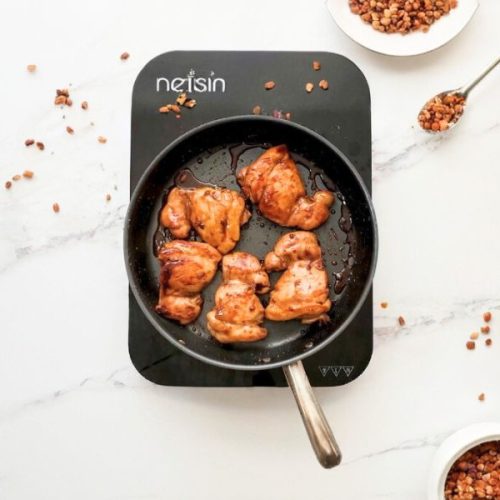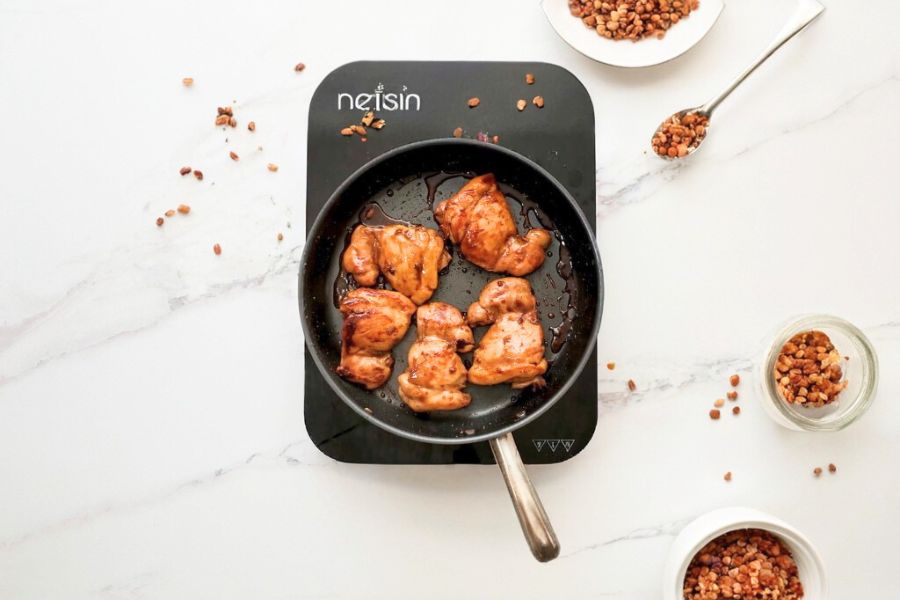This Skillet Teriyaki Chicken Thigh Recipe is a weeknight winner—simple, flavorful, and perfectly balanced between savory and sweet.
Using boneless, skinless chicken thighs ensures a tender, juicy bite every time while packing in 28 grams of lean, high-quality protein per serving.
The quick homemade teriyaki marinade, made with soy sauce, rice wine vinegar, and garlic, creates a rich glaze without relying on heavy oils or added fats, keeping the dish low in saturated fat and only 198 calories per serving.
It’s also fiber-friendly and low-carb, making it a smart option for those seeking balanced, wholesome meals.
With just 5 minutes of prep and minimal cleanup, this recipe is ideal for meal prepping or busy weeknights, offering a restaurant-quality dish in under an hour.
Its versatility pairs beautifully with rice, noodles, or fresh vegetables for a complete, nourishing dinner.
Must-Have Tools for Perfect Results
OXO Good Grips 9-Inch Whisk
Essential for blending the marinade evenly, ensuring the sugar and soy sauce combine smoothly. A reliable whisk like this is a staple for mixing dressings, batters, and sauces in any kitchen.
Ziploc Gallon Food Storage Bags
Perfect for mess-free marinating, allowing the chicken to absorb flavors evenly. These versatile bags are also great for meal prep, freezing leftovers, or storing pantry staples.
Lodge 12-Inch Cast Iron Skillet
Provides even heat distribution for perfectly seared, juicy chicken thighs. A high-quality skillet like this is a must-have for everything from pan-fried meats to one-pan dinners.
OXO Good Grips 12-Inch Tongs
Makes flipping and handling the chicken effortless while keeping hands safe from splattering oil. A kitchen essential for grilling, sautéing, and serving with ease.

Homemade Teriyaki Chicken Thighs
Equipment
- 1 9-Inch Whisk
- 1 Gallon-Sized Food Storage Bag
- 1 12-Inch Cast Iron or Nonstick Skillet
- 1 12-Inch Tongs
- 1 Small Mixing Bowl
Ingredients
- 2 tablespoons light brown sugar firmly packed
- 2 tablespoons soy sauce regular or low sodium
- 1 teaspoon rice wine vinegar red wine vinegar can be substituted
- 1 clove garlic finely minced
- 1/8 teaspoon freshly ground black pepper
- 20 ounces boneless skinless chicken thighs (approximately 5–6 thighs)
Instructions
- Prepare the Teriyaki Marinade: In a small mixing bowl, whisk together brown sugar, soy sauce, vinegar, minced garlic, and black pepper until the sugar dissolves and a smooth marinade forms. This blend will add a perfect balance of sweet and savory notes to your chicken.
- Marinate the Chicken: Place the chicken thighs into a large, sealable plastic bag or shallow dish. Pour the marinade over the chicken, seal or cover tightly, and massage gently to coat each piece thoroughly. Refrigerate for at least 30 minutes or up to 2 hours for deeper flavor infusion.
- Start Cooking in a Skillet: Preheat a large nonstick or cast-iron skillet over medium heat.Using tongs, transfer the marinated chicken thighs to the pan, discarding any leftover marinade to avoid cross-contamination.Cover with a lid and cook undisturbed for 8 minutes, allowing the meat to sear and release its natural juices.
- Flip and Glaze the Chicken: Remove the lid, carefully flip each thigh, and continue cooking for another 5 minutes, or until the internal temperature reaches 165°F (74°C). As the chicken cooks, the remaining sauce will thicken into a glossy glaze. Use your tongs to turn and coat the chicken evenly in the glaze before serving.
Notes
- Shortcut Tip: For even faster prep, whisk the marinade in advance and store it in the refrigerator for up to 2 days.
- Alternative Cuts: This recipe also works well with boneless chicken breasts or chicken tenders—adjust cooking time accordingly.
- Serving Suggestions: Pair with steamed jasmine rice, sautéed vegetables, or a fresh green salad for a balanced meal.
- Storage: Leftovers keep well in an airtight container in the refrigerator for up to 3 days and can be reheated gently on the stovetop or in the microwave.
- Flavor Booster: Add a teaspoon of fresh grated ginger to the marinade for extra zing.
Chef’s Secrets for Tender Teriyaki Chicken
The secret to perfectly juicy teriyaki chicken lies in the marinade time and cooking temperature.
Allowing the chicken thighs to marinate for at least 30 minutes helps the flavors penetrate deeply, while cooking them over medium heat ensures they stay moist without burning the glaze.
For an extra boost of flavor, try using freshly grated garlic or adding a hint of ginger to your marinade. When cooking, avoid constantly flipping the chicken—this allows a nice sear to develop, locking in those savory juices.
Using a nonstick or cast-iron skillet helps achieve even browning and a sticky, caramelized glaze without the need for excess oil.
Finally, letting the chicken rest for a couple of minutes after cooking allows the juices to redistribute, giving you a perfectly tender bite every time.
Serving Suggestions for Balanced Meals
This skillet teriyaki chicken is incredibly versatile and pairs beautifully with a variety of sides.
For a classic combination, serve it over steamed jasmine or basmati rice, drizzling any extra glaze on top.
If you’re keeping things low-carb, pair it with cauliflower rice or a crisp Asian-style salad tossed in a light sesame dressing.
It also works wonderfully with stir-fried vegetables like broccoli, snow peas, or bell peppers for added color and nutrition.
For a family-style dinner, slice the chicken into strips and serve it in lettuce wraps, on top of noodles, or inside warm tortillas for a teriyaki chicken wrap twist.
Don’t forget a sprinkle of toasted sesame seeds or chopped green onions for a restaurant-worthy finish.
Storage Tips to Keep It Fresh
Leftovers are a lifesaver, and this recipe stores beautifully for quick lunches or easy dinners later in the week. Allow the cooked chicken to cool completely before transferring it to an airtight container.
It will stay fresh in the refrigerator for up to 3 days. For longer storage, freeze the chicken thighs individually or in portions for up to 2 months; thaw in the refrigerator overnight before reheating.
When reheating, gently warm the chicken in a skillet over low heat with a splash of water or broth to keep it moist and prevent the glaze from drying out.
Avoid microwaving on high power, as it can make the chicken tough.
Frequently Asked Questions about This Recipe
1. Can I use chicken breasts instead of thighs?
Yes! Boneless, skinless chicken breasts work well, but they cook faster and can dry out if overcooked. Reduce the cooking time slightly and check the internal temperature early to ensure it reaches 165°F without losing juiciness.
2. Can I make this recipe ahead of time?
Absolutely. You can prepare and marinate the chicken up to 24 hours in advance, keeping it refrigerated until ready to cook. The flavors develop even more when marinated overnight.
3. Is there a low-sodium option for the sauce?
Yes, you can use low-sodium soy sauce or coconut aminos to cut down on salt. You can also reduce the amount of brown sugar slightly if you prefer a less sweet glaze.
4. Can I bake this instead of using a skillet?
Definitely. Arrange the marinated chicken on a baking sheet lined with foil and bake at 400°F (200°C) for about 20–25 minutes, basting with the sauce halfway through for a sticky, caramelized finish.
5. What side dishes pair best with this?
Steamed white or brown rice is a classic choice, but you can also try garlic fried rice, Asian slaw, roasted vegetables, or soba noodles. This chicken also makes a fantastic protein for rice bowls or meal-prep lunches.
This recipe has been adapted and simplified from the original version by thewholesomedish. We’ve refined the steps for a smoother cooking experience and added helpful notes, nutrition insights, and essential kitchen tools to make it even easier for home cooks.

